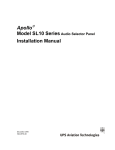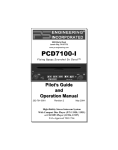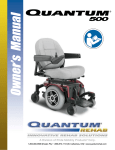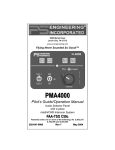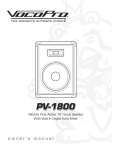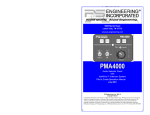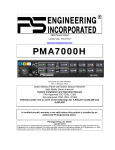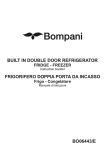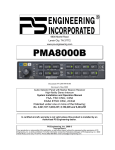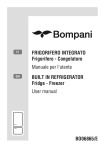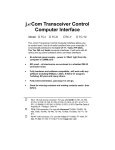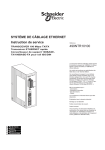Download PS Engineering PMA4000 TSO Installation manual
Transcript
Sound Quality. Sound Engineering. 9800 Martel Road Lenoir City, TN 37772 PMA4000 TSO Audio Selector Panel IntelliVox™ Intercom System Installation and Operation Manual FAA TSO C50c US Pat. No. 5, 903, 227 6,493,450 Also includes Non-TSO version, P/N 11941 Document P/N 200-041-0002 Revision 5, March 2007 PS Engineering, Inc. ©2007 Copyright Notice Note: Warranty is not valid unless this product is installed by an Authorized PS Engineering or if a PS Engineering harness is purchased. PS Engineering, Inc., 9800 Martel Road, Lenoir City, TN 37772. Phone (865) 988-9800. PS Engineering PMA4000 Series Audio Selector Panel and Intercom System Installation Manual Table of Contents Section I GENERAL INFORMATION...................................................................... 1-1 1.1 INTRODUCTION ........................................................................................... 1-1 1.2 SCOPE ............................................................................................................. 1-1 1.3 EQUIPMENT DESCRIPTION ....................................................................... 1-1 APPROVAL BASIS – FAA- TSO C50c..................................................................... 1-2 1.4 SPECIFICATIONS.......................................................................................... 1-2 1.5 EQUIPMENT SUPPLIED............................................................................... 1-2 1.6 Optional remote volume control (P/N 250-004-0020) .................................... 1-3 1.7 Optional 2 ¼”mounting plate kit (250-004-0005) ........................................... 1-3 1.8 EQUIPMENT REQUIRED BUT NOT SUPPLIED ....................................... 1-3 1.9 LICENSE REQUIREMENTS ......................................................................... 1-3 Section II -Installation ................................................................................................ 2-1 2.1 GENERAL INFORMATION .......................................................................... 2-1 2.1.1 SCOPE ......................................................................................................... 2-1 2.2 Unpacking and Preliminary Inspection............................................................ 2-1 2.3 Equipment Installation Procedures .................................................................. 2-1 2.3.1 Cooling Requirements ................................................................................. 2-1 2.3.2 Mounting Requirements .............................................................................. 2-1 2.3.3 Mounting Hole configuration ...................................................................... 2-1 2.3.4 Connector Assembly.................................................................................... 2-2 2.4 Cable Harness Wiring ...................................................................................... 2-2 2.4.1 Noise ............................................................................................................ 2-2 2.4.2 Entertainment Input ..................................................................................... 2-3 2.4.3 Radio Push-to-Talk ...................................................................................... 2-3 2.4.4 Power and 28 VDC Dropping Resistor........................................................ 2-4 2.4.5 Backlighting................................................................................................. 2-4 2.4.6 Intercom ....................................................................................................... 2-4 2.4.7 Digital recorder (11941 only) ...................................................................... 2-4 2.5 Adjustments ..................................................................................................... 2-5 2.6 Panel Installation.............................................................................................. 2-5 2.7 Post Installation Checkout ............................................................................... 2-5 2.7.1 Operational Checkout .................................................................................. 2-6 2.8 Final Inspection................................................................................................ 2-6 Section III OPERATION ......................................................................................... 3-1 3.1 SCOPE ............................................................................................................. 3-1 3.2 Audio Selector ................................................................................................. 3-1 3.2.1 Intercom Mode Selector Switch .................................................................. 3-1 3.2.2 Speaker Amplifier........................................................................................ 3-2 3.3 Mic Selector Switch......................................................................................... 3-2 3.3.1 Volume Control ........................................................................................... 3-2 3.3.2 VOX-Squelch Control ................................................................................. 3-2 3.3.3 Intercom Modes ........................................................................................... 3-3 3.3.4 Push to talk intercom mode.......................................................................... 3-4 200-041-0002 Page ii Rev 5, March 2007 PS Engineering PMA4000 Series Audio Selector Panel and Intercom System Installation Manual 3.3.5 Internal Recorder System (Part number 11941, only) ................................. 3-4 Section IV- Warranty and Service ........................................................................... 4-1 4.1 Warranty .......................................................................................................... 4-1 4.2 Factory Service ................................................................................................ 4-1 Appendix A External PTT Hook Up..........................................................................A Appendix B- Installation Drawing and Connector Layout.......................................B Appendix C Unit Connector Wiring ...........................................................................C Appendix D -Instructions for FAA Form 337 and Continuing Airworthiness .......D Appendix E RTCA DO160D (EUROCAE ED-14) Environmental Qualification Form ...................................................................................................................................E Table of Figures Figure 1-1 PMA4000 ....................................................................................................... 1-1 Figure 3-1 PMA4000 ....................................................................................................... 3-1 Figure 3-2 Mic Selector ................................................................................................... 3-2 Figure 6-1- Hole Configuration ..........................................................................................A Figure 6-2 Hole Configuration to avoid rectangular cutouts..............................................A Figure 6-3 Connector Layout..............................................................................................B Figure 6-4 Installation Diagram..........................................................................................B Table of Tables Table 3-1 Mic Muff ™ Part Numbers ............................................................................. 3-3 Table 3-1 Intercom Modes............................................................................................... 3-4 Revision History Rev. By Date Description of Change 3 Picou January 2006 Updated section 2.4.4 for power wires, allow smaller gage. 4 Picou March2006 Added information for 11941 5 Picou March2007 Clarified mounting dimensions 200-041-0002 Page iii Rev 5, March 2007 PS Engineering PMA4000 Series Audio Selector Panel and Intercom System Installation Manual Section I GENERAL INFORMATION 1.1 INTRODUCTION The PMA4000 TSO Audio Selector Panel is a right-sized solution for the audio switching needs of light aircraft. By combining basic audio selector panel, with PS Engineering’s revolutionary IntelliVox® intercom, the aircraft owner can have audio panel functionality without an investment in panel space. Before installing and/or using this product, please read this manual completely. This will ensure that you will take full advantage of all the advanced features. 1.2 SCOPE This manual provides detailed installation and operation instructions for the PS Engineering PMA4000 TSO Audio Selector Panel/Intercom Systems. This includes the following unit: Model PMA4000 TSO PMA4000-NON TSO 1.3 Description Audio Selector Panel Audio Selector Panel w/IRS Part Number 11942 11941 EQUIPMENT DESCRIPTION The PMA4000-series is a state of the art audio isolation amplifier and audio selector that contains an automatic voice activated (VOX) intercom system. It can switch two transceivers (Com 1, Com 2) and two receivers (Nav 1, Nav 2) In addition, there are four unswitched inputs, for additional audio requirements. Push buttons select the receiver audio source provided to the headphones. A SPR push-on switch on the volume control allows the user to listen to the receiver(s) selected on the cabin speaker. Except for the unswitched inputs, all speaker audio is muted during transmit. A toggle switch selects one of the two transceivers for the pilot and copilot positions in transmit. A fail-safe mode connects the pilot headphone and microphone to COM 1 if power is removed for any reason, or if the Com Selector switch is in the “Off” position. A 4-station voice activated (IntelliVox™) intercom is included in the PMA4000. Pilot isolate and ALL modes, a mono music input with "Soft Mute." A dual concentric knob pair controls pilot volume and copilot/passenger intercom volume. Figure 1-1 PMA4000 200-041-0002 Page 1-1 Rev 5, March 2007 PS Engineering PMA4000 Series Audio Selector Panel and Intercom System Installation Manual APPROVAL BASIS – FAA- TSO C50c The PMA4000 p/n 11942, Audio Selector Panels are FAA approved under TSO C50c (Audio Amplifiers). All systems comply with relevant portions of EUROCAE ED-14C/DO-160D (Environmental Conditions and Test Procedures for Airborne Equipment), ED12B/DO-178B (Software Considerations for Airborne Equipment) and ED- 18/DO-214 (Audio Systems Characteristics and Minimum Operational Performance Standards for Aircraft Audio Systems). Operation is subject to the following conditions: 1. This device may not cause harmful interference. 2. This device must accept any interference received, including interference that may cause undesired operation. The part number 11941 unit is NOT FAA Approved. 1.4 SPECIFICATIONS ENVIRONMENTAL Qualifications: Temperature Range: Operating: Storage Altitude: Audio Selector/Intercom: APPLICABLE DOCUMENTS: DIMENSIONS: WEIGHT (With Connectors): Voltage: Maximum Current: B1CABSRXXXXXXABBBBTMXXE2XXX -20ºC to +55ºC -40ºC to +85ºC Up to 25,000 feet in an unpressurized area of the cockpit. C50c, Class A RTCA/DO-214, RTCA/DO-160D Height: 1.35 in. (3.4 cm) Width: 2.40 in. (6.1 cm) Depth: 6.50 in. (16.5 cm) behind panel 12.4 oz. (0.35 kg) 11 to 33 VDC (28 Volt w/dropping resistor) 0.25 Amp (Externally protected by a 3 Amp circuit breaker.) Typical operating current: Speaker off: Speaker on, 28V, full radio volume 100 mA 250 mA Audio Selector Specifications Audio selector panel input impedance: 510 Ω Input Isolation: -60 dB (min.) Speaker Muting: -60 dB (min.) Speaker Output (into 4 Ω) with no clipping 2 Watts (min.) 14 VDC: 8 Watts (min.) 28 VDC: Receiver Inputs: 4 (Com 1, Com 2, Nav 1, Nav 2) Unswitched Inputs: 4 (examples: ADF, DME. GPS WPT, Marker, Autopilot Disconnect, Altimeter DH) Transmitter Selections: 2 (Com 1, Com 2) Speaker Impedance: 4Ω Headphone Impedance: 150 – 1000 Ω Headphone Output: 30 mW each headset, with < 10% THD into 150Ω Microphone Impedance: 150 - 600 Ω Intercom Specifications Intercom Positions: 4 places (with individual IntelliVox® circuits) Music Input: 1 (Monaural) Music Muting: >-30 dB "Soft Mute" Distortion: <1% THD @ 30 mW into 150Ω Mic Freq. Response,±3 dB: 300 Hz - 6000 Hz Music Freq. Response,± 3 dB: 100 Hz - 18kHz 1.5 EQUIPMENT SUPPLIED A. 1 ea. of the following units: 200-041-0002 Page 1-2 Rev 5, March 2007 PS Engineering PMA4000 Series Audio Selector Panel and Intercom System Installation Manual Unit PMA4000 TSO PMA4000 w/IRS B. PMA4000 Installation Kit: 250-0041-0001 Part Number 575-004-0005 475-632-0006 625-002-0001 625-002-0004 625-010-0002 425-025-0009 425-025-0010 425-020-5089 425-020-5090 701-015-1501 475-002-0002 625-025-0001 430-400-0028 430-400-0050 200-041-0002 1.6 Part Number 11942 11941 Description Faceplate (Square) Mounting Screws6-32X3/8”Phil-Pan Black Knob, outer Knob, inner Knob insert pointer Connector Shell Male Connector Shell Female Crimp Pin, male Crimp Socket, female Dropping Resistor, 15 Ω, 15 Watt, (required in 28 VDC installation) Connector Thumbscrews Connector Hood Mounting Shim– 0.028 in Mounting Shim –0.050 in. Operator's and Installation Manual Quan 1 2 1 1 1 1 1 25 25 1 4 2 1 1 1 Optional remote volume control (P/N 250-004-0020) This kit contains: 1 ea. 10KΩ Potentiometer P/N 675-020-0103 1 ea. knob, Black 1/4" Shaft w/Set Screw P/N 625-020-0005 1.7 Optional 2 ¼”mounting plate kit (250-004-0005) This kit contains: 1 ea. 2 ¼” Mounting plate for instrument hole mounting, P/N 575-004-0001 1 ea. Mounting Shim, 430-400-0090 1.8 EQUIPMENT REQUIRED BUT NOT SUPPLIED A. B. C. D. E. F. G. H. 1.9 Speaker, 4 Ω Headphones, 150 Ω mono, up to 4 as required Microphones, up to 4 as required Interconnect Wiring Contact Crimping Tool, AMP 601966-1 (or MS22520 equiv.), with Positioning Tool 601966-5 Headphone Jacks (As Required) Microphone Jacks (As Required) Circuit Breaker: 1 ea. 3 amp. LICENSE REQUIREMENTS None 200-041-0002 Page 1-3 Rev 5, March 2007 PS Engineering PMA4000 Series Audio Selector Panel and Intercom System Installation Manual Section II -Installation 2.1 GENERAL INFORMATION 2.1.1 SCOPE This section provides detailed installation and interconnect instructions for the PS Engineering PMA4000-TSO Series Audio Selector Panel/Intercom System, and PMA4000 w/IRS. Please read this manual carefully before beginning any installation to prevent damage and post installation problems. Installation of this equipment requires special tools and knowledge. The equipment must be installed by an appropriately rated Certified Aircraft Repair Station, in accordance with applicable regulations. 2.2 Unpacking and Preliminary Inspection Use care when unpacking the equipment. Inspect the units and parts supplied for visible signs of shipping damage. Examine the unit for loose or broken buttons, bent knobs, etc. Verify the correct quantity of components supplied with the list in Section 1.6 (B). If any claim is to be made, save the shipping material and contact the freight carrier. Do NOT return units damaged in shipping to PS Engineering. If the unit or accessories shows any sign of external shipping damage, contact PS Engineering to arrange for a replacement. Under no circumstances attempt to install a damaged unit in an aircraft. Equipment returned to PS Engineering for any other reason should be shipped in the original PS Engineering packaging, or other UPS approved packaging. 2.3 Equipment Installation Procedures 2.3.1 Cooling Requirements Forced-air cooling of the PMA4000 is not required. However the unit should be kept away from heat producing sources (i.e. defrost or heater ducts, dropping resistors, heat producing avionics) without adequate cooling air provided. 2.3.2 Mounting Requirements The PMA4000 must be rigidly mounted to the instrument panel of the aircraft structure and within view and reach of the pilot position(s). Installation must comply with FAA Advisory Circular AC 43.13-2A. The unit may be mounted in any area where adequate clearance for the unit and associated wiring bundle exist. 2.3.3 Mounting Hole configuration For instrument panel mounting, make openings in the panel according to the templates and drawing supplied. Depending on the instrument panel thickness, you may elect to use the shim supplied for the best button depth and mechanical contact. See Appendix B for mounting hole layout. 200-041-0002 Page 2-1 Rev 5, March 2007 PS Engineering PMA4000 Series Audio Selector Panel and Intercom System Installation Manual 2.3.4 Connector Assembly The unit connectors are DB25 type. The unit has a male (bottom) a female (top), to prevent incorrect connections. The top connector is generally the output, and the bottom connector is generally the input connections. These are crimp-type connectors. The AMP Contact Crimping Tool, AMP 601966-1 (or MS22520 equiv.), with Positioning Tool 601966-5 must be used to ensure good quality harness. 2.4 Cable Harness Wiring Referring to Appendix C, assemble a wiring harness as required for the installation. All wires must be MIL-SPEC in accordance with current regulations. Two- and threeconductor with shield wire must be used where indicated, and be MIL-C-27500 or equivalent specification. Proper stripping, shielding and soldering technique must be used at all times. It is imperative that the correct wire and techniques be used for proper operation. The shield should not be used as ground return. Terminate the shields with a short jumper to the appropriate pin as shown in Appendix C, as close to the unit connector as practical. Refer to FAA Advisory Circular 43.13-2A for more information. Failure to use correct techniques may result in improper operation, electrical noise or unit failure. Damage caused by improper installation will void the PS Engineering warranty. 2.4.1 Noise Due to the variety and the high power of radio equipment often found in today's general aviation aircraft, there is a potential for both radiated and conducted noise interference. The PMA4000 power supply is specifically designed to reduce conducted electrical noise on the aircraft power bus by at least 50dB. Although this is a large amount of attenuation, it may not eliminate all noise, particularly if the amplitude of noise is very high. There must be at least 13 VDC present at the bottom connector, pin 13, of the PMA4000 for the power supply to work in its designed regulation. Otherwise, it cannot adequately attenuate power line noise. Shielding can reduce or prevent radiated noise (i.e., beacon, electric gyros, switching power supplies, etc.) However, installation combinations can occur where interference is possible. The PMA4000s were designed in a RFI hardened chassis and have internal Electromagnetic Interference (EMI) filters on all inputs and outputs. Ground loop noise occurs when there are two or more ground paths for the same signal (i.e., airframe and ground return wire). Large cyclic loads such as strobes, inverters, etc., can inject noise signals onto the airframe that are detected by the audio system. Follow the wiring diagram very carefully to help ensure a minimum of ground loop potential. Use only Mil Spec shielded wires (MIL-C-27500, or better). Radiated signals can be a factor when low level microphone signals are "bundled" with current carrying power wires. Keep these cables physically separated. It is very important that you use insulated washers to isolate the ground return path from the airframe to all headphone and microphone jacks. 200-041-0002 Page 2-2 Rev 5, March 2007 PS Engineering PMA4000 Series Audio Selector Panel and Intercom System Installation Manual 2.4.2 Entertainment Input A single entertainment device (CD player, cassette player, etc.) can be connected to the unit. Install a 1/8-inch stereo jack in a convenient location so that the pilot can plug in the entertainment device into the system. For a stereo input, we recommend tying the left and right channels (tip and ring) together, so both stereo channels are provided to the monaural audio panel, and the audio amplitude available to the audio panel is increased. Audio signal at the entertainment input must be a minimum of 1V P-P for optimum music performance. We have noticed that the portable devices using 4 batteries seem to work better than the 2-cell types. Also we have found that some cigarette-lighter adapters introduce noise into the system due to the voltage switching power supply. 2.4.2.1 Soft Mute The PMA4000-system incorporates a "Soft Mute" system. This will mute the entertainment devices during ICS or radio traffic. The entertainment input (P2, pin 25 and 13) is heard by everyone (except by the pilot in ISO mode). NOTE: The Soft Mute Enable switch is connected between P2, Pin 5 and ground. When this pin is grounded, the soft mute is inactive, and the PMA4000 is in “Karoake” Mode. Local oscillators and internal signals from some entertainment equipment can cause undesired interference with other aircraft systems. Before takeoff, operate the entertainment devices to determine if there is any adverse effect within the aircraft systems. If any unusual operation is noted in flight, immediately switch off the entertainment devices. NOTE: Use the low-level output of any entertainment device to connect to the audio panel. Maximum signal level is 3 VAC p-p. DO NOT use a speaker-level output, this will cause internal damage in the audio panel. To use a speaker level, install an AudioLink adapter (part number 101PL2), available from Crutchfield at 1-800-955-3000 2.4.3 Radio Push-to-Talk An important part of the installation is the PTT (Push-To-Talk) switches that allow the use of your aircraft communications radio for transmissions. There are three typical configurations that can be used. Select the case that best fits the installation. Only the person who presses their PTT switch will be heard over the radio. If the pilot and copilot both use the PTT, the copilot position has access to the radio. The pilot position will have PTT control regardless of the copilot when the PMA4000 is in the FAIL-SAFE mode. CASE I: PTT is built into both pilot and copilot yokes. 200-041-0002 Page 2-3 Rev 5, March 2007 PS Engineering PMA4000 Series Audio Selector Panel and Intercom System Installation Manual CASE II: PTT is in pilot yoke only. This configuration requires a modified external PTT switch plugged into the copilot's microphone jack. (See Appendix A). When the copilot's PTT is pressed, the intercom switches the mic audio from pilot to copilot mic. CASE III: No built in PTT. This requires two built in PTTs to be installed, or modified external PTT switches to be used. Modify external PTT as required (See Appendix A). 2.4.4 Power and 28 VDC Dropping Resistor The PMA4000 is compatible with both 13.8 and 28 Volt DC systems. A three (3) Amp circuit breaker is required. Power and ground wires should be at least #20AWG twisted pair. If installed in a 28V aircraft, a 15Ω, 15 watt dropping resistor must be installed in the power input. 2.4.5 Backlighting The PMA4000 has automatic lamp dimming of the buttons controlled by a photo-resistor. The photocell located at the center of the unit face will automatically adjust the intensity of the push-button lamps. 2.4.6 Intercom All mic and headphone jacks must have insulating washers, the cable must be Teflon coated, twisted-shielded wire, and the shield must only be connected to the ground return wire only at the intercom connector. NOTE: This harness can be custom made by PS Engineering, Inc. Simply call the factory (1-800-ICS-AERO) and obtain a wire harness work-sheet. Or obtain at website. The harness will be made to your specifications and fully functionally tested. All hardware is included. 2.4.6.1 Push-to-talk intercom PMA4000 units include a push-to-talk intercom capability. In some extremely high noise environments, it may be desirable to have a push to talk (PTT) intercom, instead of relying on voice-activation (IntelliVox™). To operate the PTT, simply ground P2, Pin 16 (PTT Enable) through a switch. Then, grounding the appropriate pin on the P2 connector through a momentary switch (Pin 4 for the pilot, Pin 17 for copilot) will open only that intercom channel. The passengers do not have PTT capability. Their IntelliVox™ remains active when the ICS PTT enable is grounded. If PTT is desired for the passenger position, add a momentary, normally open (NO) switch in series with the mic audio input to P2, pin 14 and 15. 2.4.7 Digital recorder (11941 only) If the PMA4000-series unit is a part number 11941 there is an internal recorder built into the unit. This stores the last 60 seconds of radio traffic from the selected Com transceiver (the one selected for transmit). Everyone who hears the radio will hear the playback, it will be present in the speaker (if selected) and it will mute the music. 200-041-0002 Page 2-4 Rev 5, March 2007 PS Engineering PMA4000 Series Audio Selector Panel and Intercom System Installation Manual To use this function, a normally open (NO) momentary switch is installed between the bottom connector P1, pin 11 and aircraft ground. A low-current switch is recommended. A radio signal of more than 1 VRMS is needed to trigger the IRS. Therefore, if the IRS does not seem to be recording, increase the aircraft radio volume slightly. 2.5 Adjustments The PMA4000 is factory adjusted to accommodate the typical requirements for most aircraft configurations. There is an adjustment for the cabin speaker volume, accessed through the left side (viewed from the front) of the unit. To make the necessary adjustments, use a small jeweler's slotted screwdriver. Turning the adjustment counter clockwise will increase the volume. 2.6 Panel Installation 1. Insert the PMA4000 from behind the instrument panel. 2. Use caution when aligning the holes for the knobs, toggle switches and push-buttons. 3. If necessary, add the shim spacers between the unit and the back side of the instrument panel, so the selector buttons are the correct depth for the shoulder of the switch to mate with the front plate. Note: The total panel thickness should be about 0.100” Add the necessary shims to come as close to 0.100” as possible. For instance, a .050” instrument panel, add a .050” shim. 4. Carefully place the aluminum face-plate over the knob shafts and push-buttons, seating the push-button shoulders in the panel. 5. Secure the unit, using the two # 6-32 round head screws provided. 6. Install the knobs over the volume control shaft. 2.6.1.1 Instrument hole mounting The PMA4000 can be mounted in a 2 ¼-inch instrument hole, using the adapter plate, part number 575-004-0001 (not supplied). 1. Insert a .090” shim (430-400-0090, not supplied) between the PMA4000 and the mounting plate. Use caution to align the selector buttons in the openings. 2. Secure the mounting plate to the unit and shim assembly with the two # 6-32 round head screws provided. Use caution to align the selector buttons in the openings 3. Mount the intercom and plate to the instrument panel from behind, using aircraft instrument hardware, not supplied. 4. Install the knobs over the volume control shafts. 2.7 Post Installation Checkout After wiring is complete, verify aircraft power is ONLY on pin 13 of the bottom connector, and airframe ground on bottom connector pin 25. Failure to do so will cause serious internal damage and void PS Engineering's warranty. To avoid stray voltages, the other avionics should be turned off. 200-041-0002 Page 2-5 Rev 5, March 2007 PS Engineering PMA4000 Series Audio Selector Panel and Intercom System Installation Manual 2.7.1 Operational Checkout 1. Apply power to the aircraft and avionics. 2. Plug headsets into the pilot, copilot and passenger positions. 3. Place the Mic Selector Switch to the Com 1 position. 4. Verify that the C1 light comes on. If the push-button is flashing, stop testing and troubleshoot the microphone PTT installation. A flashing indicator in the COM select button indicates that the key line is grounded. 5. Verify proper transmit and receive operation on the pilot and copilot positions, noting that the PTT switches allows proper transmission on the selected transceiver. 6. Verify that the button blinks when the selected transmitter is active. 7. Verify that switching to the C2 position causes the button to illuminate and the Com 2 receiver to be heard. Verify transmit and receive on Com 2. 8. Press the Com 1 push button, and verify that Com 1 and Com 2 receive audio can be heard. 9. Verify proper operation of the Nav 1 and Nav 2 receiver sources by selecting them using the N1 and N2 buttons. Note that the button for the receiver sources stays in, and the button illuminates to show which source is in use. 10. Push in volume control to activate the speaker (SPR) switch. Verify that all selected audio is heard in the cockpit speaker. Verify that the audio mutes when the mic is keyed. 11. Verify proper Intercom system operation in the ALL, and ISO modes. 12. Verify that the audio selector panel system does not adversely affect any other aircraft system by systematically switching the unit on and off, while monitoring the other avionics and electrical equipment on the aircraft. 2.8 Final Inspection. Verify that the wiring is bundled away from all controls and no part of the installation interferes with aircraft control operation. Move all controls through their full range while examining the installation to see that no mechanical interference exists. Verify that the cables are secured to the aircraft structure in accordance with good practices, with adequate strain relief. Ensure that there are no kinks or sharp bends in the cables. Verify that the cables are not exposed to any sharp edges or rough surfaces, and that all contact points are protected from abrasion. Complete log book entry, FAA Form 337, weight and balance computation and other documentation as required. Return completed warranty registration application to PS Engineering. 200-041-0002 Page 2-6 Rev 5, March 2007 PS Engineering PMA4000 Series Audio Selector Panel and IntelliVox™ Intercom System Installation Manual Section III OPERATION GENERAL INFORMATION 3.1 SCOPE This section provides detailed operating instructions for the PS Engineering PMA4000 TSO Audio Selector Panel/Intercom Systems. Please read it carefully before using the equipment so that you can take full advantage of its capabilities. This section is divided into three sections covering the basic operating areas of the PMA4000 systems. They are: Audio Selector, Transceiver Selection and Intercom. 3.2 Audio Selector Through the use of four latched, push-button, backlit switches, it is possible to select any or all receiver audio. When selected, an internal backlight will illuminate indicating which audio source is selected. The Com toggle switch controls what transceiver is being heard by the pilot and copilot. "C1" (Com 1) and "C2" (Com 2) push-buttons select the receiver, and are used to monitor a com that is not selected for Figure 3-1 PMA4000 transmit. You will always hear the audio from the transceiver that is selected by the 2-position mic selector toggle switch. The users can identify which receivers are selected by noting which push-button switches are illuminated. Push buttons labeled N1 (Nav 1), N2 (Nav 2) are "latched" type switches. When one of these buttons is pressed, it will stay in the "in" position. Press the switch again and it be in the "out" position and remove that receiver from the audio. While selected, the switch will also be annunciated by an internal lamp. 3.2.1 Intercom Mode Selector Switch Unit power is turned on and off by the mode selector switch. In the OFF or "FAIL-SAFE" position, the pilot is connected directly to Com 1 allowing transmit and receive capability regardless of unit condition. Any time power is removed or turned OFF, the audio selector will be placed in the fail-safe mode. The switch is a 3position mode switch that allows the pilot to tailor the intercom function to best meet the situation. ISO: (Up Position): The pilot is isolated from the intercom and is connected only to the aircraft radio. He will hear the aircraft radio reception (and sidetone during radio transmissions if provided by the transceiver). Copilot and passengers will hear the intercom and music on Entertainment input, but not the aircraft radio receptions or pilot transmissions. 200-041-0002 Page 3-1 Rev 5, March 2007 PS Engineering PMA4000 Series Audio Selector Panel and IntelliVox™ Intercom System Installation Manual ALL: (Middle Position): All parties will hear the aircraft radio, intercom, and music from entertainment input. However, during any intercom communications, the music volume automatically decreases when SoftMute is active . The music volume increases gradually back to the original level after communications have been completed. 3.2.2 Speaker Amplifier Pressing the volume control will activate the cockpit speaker. This switch will place all selected audio on the cockpit speaker when selected. The speaker is automatically muted when the radio push to talk (PTT) is active. To reduce power consumption and internal heat buildup, switch off the speaker amplifier when not in use. 3.3 Mic Selector Switch Figure 3-2 Mic Selector The up switch position COM 1. Both pilot and copilot will be connected to the Com l transceiver. While in the COM 1 or COM 2 mode, the intercom functions normally. Both the pilot and copilot have transmit capabilities on the selected transceiver. All hear the selected audio if the intercom is in the ALL mode. Only the person who presses their Push To Talk (PTT), will be heard over the aircraft radio. Placing the toggle switch in the COM 2 position will place pilot and copilot on Com 2. The PMA4000-Series has an automatic selector mode. Audio from the selected transceiver is automatically heard in the headsets and speaker (when selected). You can check this function by switching from COM 1 to COM 2 and watch the selected audio light on the selector change from C1 to C2. This ensures the pilot will never transmit on a radio is not listening to. When switching from COM 1 to COM 2 while Com 2 has NOT been selected, Com 1 audio will be switched off. In essence, switching the mic selector will not effect the selection of Com receiver audio. 3.3.1 Volume Control The pilot volume control knob adjusts the loudness of intercom and music in the pilot’s headphones only. It has no effect on selected radio audio levels. The copilot volume control adjusts the loudness of the intercom and music in the copilot headset. The passenger volume is also adjusted by the copilot volume control. Most general aviation headsets have a built-in volume control, so volume can be adjusted “locally.” The copilot volume control is also controllable through the rear connector, so a tandem aircraft can adjust the volume from a different location. 3.3.2 VOX-Squelch Control The PMA4000 incorporates PS Engineering’s revolutionary IntelliVox™. No adjustment of the squelch control is required. Through two individual signal processors, the ambient 200-041-0002 Page 3-2 Rev 5, March 2007 PS Engineering PMA4000 Series Audio Selector Panel and IntelliVox™ Intercom System Installation Manual noise appearing in all four microphones is constantly being sampled. Non-voice signals are blocked. When someone speaks, only their microphone circuit opens, placing their voice on the intercom. The system is designed to block continuous tones, therefore people humming or whistling in monotone may be blocked after a few moments. For best performance, the headset microphone must be placed within ¼ inch of your lips, preferably against them. It is also a good idea to keep the microphone out of a direct wind path. Moving your head through a vent air stream may cause the IntelliVox™ to open momentarily. This is normal. For optimum microphone performance, PS Engineering, Inc. recommends installation of a Microphone Muff Kit from Oregon Aero (1-800-888-6910). This will not only optimize VOX performance, but will improve the overall clarity of all your communications. Table 3-1 Mic Muff ™ Part Numbers Manufacturer Dynamic Electret M87 Dynamic H10-30 H10-20, H10-40 H10-13.4 15K & 20K Mic Muff™ Part Number 90010 90015 90020 90010 90015 90015 90015 Peltor 7003 7004 90010 90015 Pilot 11-20 & 11-90 90015 Bose David Clark Lightspeed Model Sennheiser Telex 90015 Airman 750 AIR3000 90015 90010 3.3.3 Intercom Modes The audio selector panel has provisions for an entertainment input device. While in the ISO (Isolate) mode, only the copilot and the four passengers will hear entertainment device. In normal operation, whenever a person speaks or if the aircraft radio becomes active, the music will automatically mute and then will gradually return to the original listening level when the radio or intercom activity ceases. If a stereo entertainment device is used, the left and right channels can be combined in the plug to provide full sound. 200-041-0002 Page 3-3 Rev 5, March 2007 PS Engineering PMA4000 Series Audio Selector Panel and IntelliVox™ Intercom System Installation Manual Table 3-1 Intercom Modes Mode Isolate Pilot Hears A/C Radio Pilot Sidetone (during radio transmission, if provided by aircraft radio) Copilot Hears Copilot and passenger intercom Entertainment Passenger Hears Passenger and Copilot intercom Entertainment All Pilot Copilot A/C Radio Passengers Entertainment Copilot Pilot A/C Radio Passengers Entertainment Passengers Pilot Copilot A/C Radio Entertainment Comments This mode allows the pilot to communicate with the air traffic control without the copilot or passengers bothered by the conversations. Copilot and passengers can continue to talk and listen to music This mode allows all on board to hear radio reception as well as communicate on the intercom. Music and intercom is muted during intercom and radio communications 3.3.4 Push to talk intercom mode In some extremely high noise environments, it may be desirable to have a push to talk (PTT) intercom, instead of relying on voice-activation (VOX). In the PMA4000 audio panel the PTT intercom capability is added. To operate the PTT, Activate the panelmounted VOX override switch. Then, the ICS PTT switch on the pilot or copilot side will allow voice on the intercom. 3.3.5 Internal Recorder System (Part number 11941, only) The PMA4000 (part number 11941) has an available internal recorder option. This stores the last 60 seconds of radio traffic from the selected Comm transceiver (the one selected for transmit). The recorder function is automatic. Pressing the momentary switch associated with the playback, will cause the last message to played (incoming radio and transmit sidetone). This will be heard in all headsets and speaker (if selected). To hear older messages, push the playback button repeatedly to “back up” the recorder, until the desired message is heard. Holding the IRS playback button for three seconds will stop the message playback and queues the system to the next preceding message. This allows quick access to previous messages. The recorder is a continuous loop, and newest ones will overwrite the oldest messages. The IRS has an internal squelch that prevents storing ‘dead’ air. A radio signal of more than 1 VRMS is needed to trigger the IRS. Therefore, if the IRS does not seem to be recording, increase the aircraft radio volume slightly. 200-041-0002 Page 3-4 Rev 5, March 2007 PS Engineering PMA4000 Series Audio Selector Panel and IntelliVox™ Intercom System Installation Manual Section IV- Warranty and Service 4.1 Warranty In order for the factory warranty to be valid, the installations in a certified aircraft must be accomplished by an FAA- certified avionics shop and authorized PS Engineering dealer. An FAA Form 337 must also be accompanied by the warranty card for this warranty to be in effect. If the unit is being installed by in an experimental aircraft by the owner/builder, a factory-made harness must be installed for the warranty to be valid. PS Engineering, Inc. warrants this product to be free from defect in material and workmanship for a period of one (1) year from the date of purchase. PS Engineering, Inc., at its option, will send a replacement unit at our expense if the unit should be determined to be defective after consultation with a factory technician. This warranty is not transferable. Any implied warranties expire at the expiration date of this warranty. PS Engineering SHALL NOT BE LIABLE FOR INCIDENTAL OR CONSEQUENTIAL DAMAGES. This warranty does not cover a defect that has resulted from improper or unreasonable use or maintenance as determined by us. This warranty is void if there is any attempt to dissemble this product without factory authorization. This warranty gives you specific legal rights, and you may also have other rights which may vary from state to state. Some states do not allow the exclusion of limitation of incidental or consequential damages, so the above limitation or exclusions may not apply to you. 4.2 Factory Service The unit is covered by a one-year limited warranty. See warranty information. Contact PS Engineering, Inc. at (865) 988-9800, or at www.ps-enginering.com before you return the unit. This will allow the service technician to provide any other suggestions for identifying the problem and recommend possible solutions. After discussing the problem with the technician and you obtain a Return Authorization Number, ship product to: Note: PS Engineering will not be responsible for units shipped in US Mail. Service Department PS Engineering, Inc. 9800 Martel Rd Lenoir City, TN 37772 Phone (423) 988-9800 FAX (423) 988-6619 Email: [email protected] 200-041-0002 Page 4-1 Rev 5, March 2007 PS Engineering PMA4000 Series Audio Selector Panel and IntelliVox™ Intercom System Installation Manual Appendix A External PTT Hook Up Part of the installation includes the installation of PTT (Push To Talk) switches that allow the use of your aircraft radio for communications transmissions. There are three configurations that can be used; you must select the case that best fits your installation. NOTE: Only the person who presses their PTT switch will be heard over the radio. CASE I The PTT is built into the pilot and copilot yokes Simply install the plugs from the headset into the aircraft headphone jacks. Then use the yoke mounted PTT to transmit. No other action is required. CASE II Built in PTT only on the pilot side only This configuration requires a modified external PTT switch plugged into the copilot's mic jack. (See Details Below) When the copilot's PTT is depressed, this activates an internal relay that switches the mic audio to the aircraft radio from the pilot to the copilot. Case III No built in PTT switch at all. Two built-in PTT must be installed, or two external, modified PTT switches will be required for both the pilot and copilot. Modifications to the PTT are required. (See details below) Push To Talk Modifications When received from the manufacturer, an after-market PTT switch opens the mic audio path to the "ring" connection of the PTT mic plug until the button is pressed. When the PTT is between the intercom and the headset, the intercom function will not work unless the PTT switch is depressed. A simple modification can be performed to allow proper intercom operation. NOTE: This mod does not alter normal operation. Below are some examples of typical modifications. Contact PS Engineering or the PTT manufacturer for more details if necessary. Procedures For David Clark PTT 1. 2. 3. Unscrew the round black plastic cover from the jack. Connect the joined black wires to the red wire. Replace the round black plastic cover. Procedures for Telex PT-200 1. 2. 3. 4. 5. Unscrew the round black plastic cover from the jack. Cut the red wire in the middle of the wire. Strip both ends of the insulation. Solder the two ends to the ground lug to the PTT jack. Replace the round black plastic cover. Procedures for Telex PT-300 1. 2. 3. 4. Unscrew the round black plastic cover from the plug jack. Remove the heat shrink material from the joined black wires. Solder these two wires to the lug that has a white wire already soldered to it. Replace the round black plastic cover 200-041-0002 Appendix A Rev 5, March 2007 PS Engineering PMA4000 Series Audio Selector Panel and IntelliVox™ Intercom System Installation Manual Appendix B- Installation Drawing and Connector Layout 0.950 0.130 0.900 0.160 DIAMETERS: A - 3/16" B - 1/4" C - 3/8" 0.400 A B 0.910 A B B 0.420 C 0.500 0.810 0.250 0.270 Figure 6-1- Hole Configuration Drill 4 x 0.5" holes for push buttons 0.950 0.740 0.290 0.360 D D D A B D A B B C DIAMETERS: A - 3/16" B - 1/4" C - 3/8" D - 1/2" 0.500 0.420 0.810 0.270 Figure 6-2 Hole Configuration to avoid rectangular cutouts By pre-drilling pilot holes, and then drilling ½” holes as shown, the installer can avoid nibbling and filing a square opening. 200-041-0002 Appendix B Rev 5, March 2007 Pilot Phones Lo Pilot Phone Hi Copilot Phone Lo Copilot Phone Hi Pass 1 & 2 Phones Lo Pass 1 & 2 Phones Hi Pot Wiper Vol Pot Lo Vol Pot Hi Copilot Mic Hi Copilot Mic Aud Lo Copilot Mic PTT Pilot Mic Lo Pilot Mic PTT Pilot Mic Aud Hi Com 1 Mic Aud Hi Com 1 Mic Aud Lo Com 1 PTT Com 2 Mic Aud Lo Com 2 Mic Aud Hi No Connect Com 2 PTT Speaker Output Aircraft Ground Power (14 VDC) Pass 1 Mic Aud Lo Pass 1 Mic Hi Pass 2 Mic Lo Pass 2 Mic Hi PTT ICS Lo PTT ICS Enable Pilot ICS PTT Copilot ICS PTT Music Mute Disable Com 2 Aud Hi Com 2 Aud Lo Com 1 Aud Hi Com 1 Aud Lo Unsw Audio 4 Hi Unsw Aud 3 Hi Unsw Aud 2 Hi Unswitched Aud Lo Unsw Aud 1 Hi Unsw Aud 1 Lo Nav 2 Aud Hi Nav 2 Aud Lo Nav 1 Aud Hi Nav 1 Aud Lo Music Input Lo Music Input Hi PS Engineering PMA4000 Series Audio Selector Panel and IntelliVox™ Intercom System Installation Manual Top Connector 14 15 16 17 18 19 20 21 22 23 24 25 1 2 3 4 5 6 7 8 9 10 11 12 13 Bottom Connector 1 2 3 4 5 6 7 8 9 10 11 12 13 14 15 16 17 18 19 20 21 22 23 24 25 Figure 6-3 Connector Layout 2.435 in Unit Face Plate Instrument Panel 200-041-0002 6.1 in 8.015 in #6 x 32 (2ea) Shim (.050" Shown) 1.75 in 1.54 in 1.915 in Figure 6-4 Installation Diagram Appendix B Rev 5, March 2007 PS Engineering PMA4000 Series Audio Selector Panel and IntelliVox™ Intercom System Installation Manual Appendix C Unit Connector Wiring P1 Bottom Unit Connector Sub-D DB-25 Male on unit Mating connector DB-25 Female P2 Top Connector Sub-D DB-25 Female on unit Mating Connector DB-25 Male Com 1 Audio Hi Com 1 Audio Lo Com 2 Audio Hi Com 2 Audio Lo Note 10 15 ohm, 15 Watt 3A Power In Ground 13 25 Cabin Speaker Audio Hi 12 Pilot Phone Audio Hi Pilot Phone Audio Lo 14 1 Pilot Headphone Jack Copilot Phone Audio Hi Copilot Phone Audio Lo 15 2 Copilot Headphone Jack Pass 1 & 2 Phones Hi Pass 1& 2 Phones Lo 16 3 Pilot Mic PTT Pilot Mic Audio Hi Pilot Mic Audio Lo 20 8 7 Copilot Mic PTT Copilot Mic Audio Hi Copilot Mic Audio Lo 19 18 6 Com 1 PTT Com 1 Mic Audio Hi Com 1 Mic Audio Lo 22 21 9 Com 2 PTT Com 2 Mic Audio Hi Com 2 Mic Audio Lo 24 23 10 12 or 24 VDC Passenger 1 Phones Passenger 2 Phones Pilot Mic Jack Pilot PTT Copilot Mic Jack Copilot PTT 19 7 Com 1 VHF Tansceiver 18 6 PTT ICS Enable 16 Pilot ICS PTT 4 Copilot ICS PTT 17 ICS PTT Lo 3 See Note 9 Com 2 VHF Tansceiver Remote Volume Control 5 4 17 3 IRS Playback 11 Vol Hi Pot Wiper Vol Lo Ground Note 6 See Note 7 NOTES: Nav 1 Audio in Hi Nav 1 Audio in Lo 24 12 Nav 1 Nav 2 Audio in Hi Nav 2 Audio in Lo 23 11 Nav 2 Unswitched Audio In 1 Unsw. Audio in 1 Lo 22 10 Rcvr 1 Unswitched Audio In 2 21 Rcvr 2 Unswitched Audio In 3 8 Rcvr 3 Unswitched Audio In 4 Unswitched Audio Lo 20 9 Rcvr 4 Pass 1 Mic Audio Hi Pass 1 Mic Audio Lo 14 1 Pass 2 Mic Audio Hi Pass 2 Mic Audio Lo 15 2 Music Input Hi Music Input Lo 13 25 Music Mute no connection 1. All wire must conform to MIL-22759 or 27500. Minumum 24 gage shielded wire. USe 20 AWG for power and ground. 2. Use 2- and 3--conductor with shield as indicated. 3. Use insulating washers on all jacks. 4. Connect shields at unit end only 5. Music input is monaural. To connect stereo, tie left and right channels together. 6. See Section 2.4.7 for details on tandem Volume controls. A 10K pot is recommended (not supplied) Connect shield to same pin as pass mic (P1, pin 3) 7. IRS Playback, 11941 only 8. Switching P2, Pin 5 to ground prevents radio and intercom from muting the music. 9. If a Push-to-talk intercom operation is desired Connect pins 16, 4, 17, and 3. This is only recommended in extremely high noise conditions. 10. In 28VDC aircraft, install a 15 Ohm, 15 Watt (701-015-1501) dropping resistor to reduce heat generated by the speaker amplifier. Pass 1 Mic no connection Pass 2 Mic Music Jack 5 See Note 8 200-041-0002 Appendix B Rev 5, March 2007 PS Engineering PMA4000 Series Audio Selector Panel and IntelliVox™ Intercom System Installation Manual Appendix D -Instructions for FAA Form 337 and Continuing Airworthiness Example for FAA Form 337 One method of airworthiness approval is through an FAA Form 337, Major Repair and Alteration (Airframe, Powerplant, Propeller, or Appliance) In the case of the PMA4000 TSO (11942, only) audio panel you may use the following text as a guide. Installed FAA-TSO Approved 4-place intercom/audio selector panel, PS Engineering PMA4000, part number 11942 at station . Installed per AC43.132, Chapter 2, paragraph 23 (Instrument Panel Mounting). Installed per PS Engineering Installation Operators Manual P/N 200-041-_______, revision (X), dated _____, _______. Interface to existing aircraft radios in accordance with installation manual and in compliance with practices listed in AC43.13-2, Chapter 2. All wires are Mil-Spec 22759 or 27500. Connection to the aircraft dimmer bus is accomplished per the installation manual and . Power is supplied to the unit through a 1A circuit breaker (type and part number), and total electrical load does not exceed % of the electrical system capacity with the PMA4000 added. Aircraft equipment list, weight and balance amended. Compass compensation checked. A copy of the operation instructions, contained in PS Engineering document 200-041-_______, revision _, ______ is placed in the aircraft records. All work accomplished listed on Work Order . Sample ICA Checklist for PS Engineering Audio Panels: Section 1 2 Introduction Description Item 3 4 5 6 Controls Servicing Maintenance Instructions Troubleshooting 7 Removal and replacement information 8 9 10 11 12 13 14 15 16 Diagrams Special Inspection Requirements Protective Treatments Structural Data Special Tools Not Applicable Recommended Overhaul Periods Airworthiness Limitations Revision 200-041-0002 Information Installation of audio control panel and intercommunications system. Installation as described in manufacturer’s installation manual referenced on FAA Form 337, including interface with other avionics audio as required. See installation and operator’s guide referenced on FAA Form 337. None Required On Condition, no special instructions In the event of a unit problem, place the unit into “off,” “fail-safe” and/or “emergency” mode. This allows pilot communications using COM 1. Follow checkout instructions in the installation manual referenced on the FAA Form 337. For a specific unit fault, contact the manufacturer at (865) 988-9800 for special instructions. Removal: Remove knobs. Using a Philips screw drier, carefully remove the 2 screws through the face plate. The unit is then removed from the rear. Installation, Reverse installation procedure. Not applicable Not Applicable Not Applicable Not Applicable None Not Applicable None Not Applicable To be determined by installer Appendix D Rev 5, March 2007 PS Engineering PMA4000 Series Audio Selector Panel and IntelliVox™ Intercom System Installation Manual Appendix E RTCA DO160D (EUROCAE ED-14) Environmental Qualification Form Nomenclature: Audio Selector Panel/Intercom Part Number:11942 FAA TSO Number: C50c Manufacturer: PS Engineering Incorporated 9800 Martel Road Conditions Temperature and Altitude Low Temperature High Temperature In-flight Loss of Cooling Altitude Decompression Overpressure Temperature variation Humidity Shock Operational Crash Safety Vibration Explosion Waterproofness Fluids Susceptibility Sand and Dust Fungus Salt Spray Magnetic Effect Power input Voltage Spike Audio Frequency Susceptibility Induced Frequency Susceptibility Radio Frequency Susceptibility Radio Frequency Emission Lightning Induced Transient Susceptibility Lightning Direct Effects Icing Electrostatic Discharge Test 200-041-0002 Section 4.0 4.5.1 4.5.2 4.5.4 4.6.1 4.6.2 4.6.3 Lenoir City TN 37772 Conducted Tests Equipment tested to CAT B1 -55° C Storage, -20°C Low Operating (B1) +85°C Storage, +70°C High Operating Not Applicable, no cooling required 25,000’ unpressurized Not Applicable Not Applicable 5.0 6.0 7.0 7.2 7.3 8.0 9.0 10.0 11.0 12.0 13.0 14.0 15.0 16.0 17.0 18.0 19.0 20.0 21.0 22.0 Equipment tested to Category S R Category X, not tested Category X, not tested Category X, not tested Category X, not tested Category X, not tested Category X, not tested Equipment tested to Category Z Equipment tested to Category B Equipment tested to Category B Equipment tested to Category B Equipment tested to Category B Equipment tested to Category T Equipment tested to Category M Equipment tested to Category XXE2 23.0 24.0 25.0 Category X not tested Category X, not tested Category X, not tested Appendix E Equipment tested to Category C Equipment tested to Category A Equipment tested Category B Rev 5, March 2007























